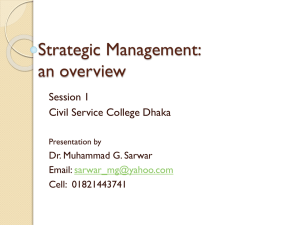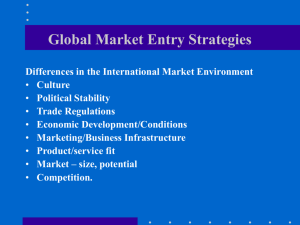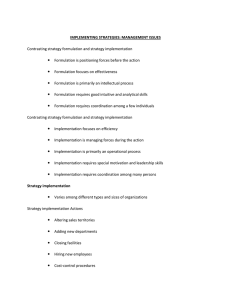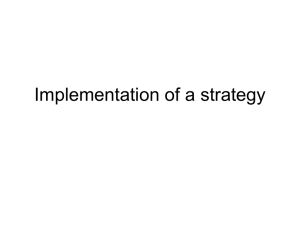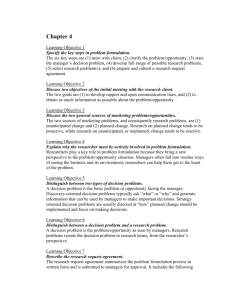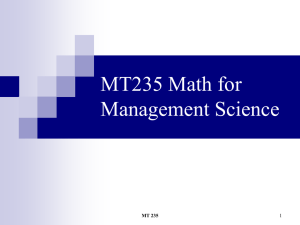Strategic Management
advertisement
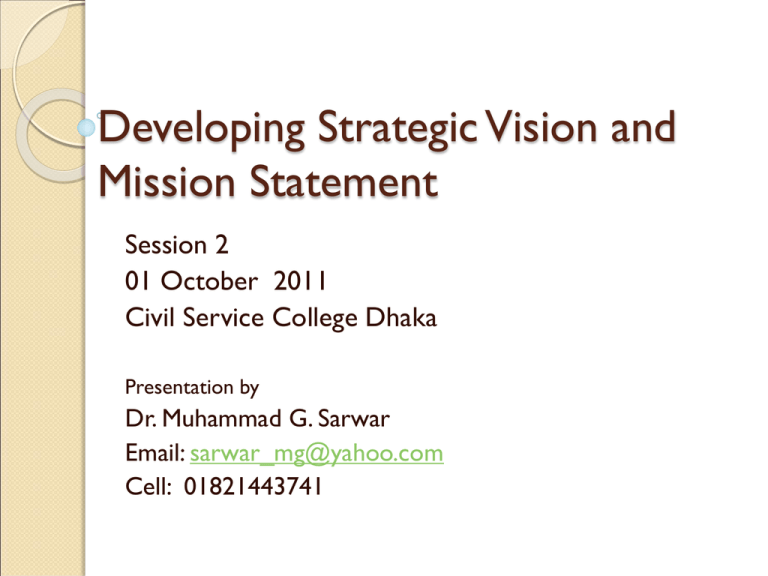
Developing Strategic Vision and Mission Statement Session 2 01 October 2011 Civil Service College Dhaka Presentation by Dr. Muhammad G. Sarwar Email: sarwar_mg@yahoo.com Cell: 01821443741 Presentation Contents of 1st Session Strategic Management: course outline Strategic Management: references What is Strategic Management? Stages of Strategic Management Strategic Management Model Benefits of Strategic Management Why Strategic Planning/Management may fail? Strategic Management and Business Ethics Guidelines for Effective Strategic Management 2 Presentation Contents of 2nd Session Selective review of topics discussed in last session Strategy Making Hierarchy Developing Organization's Vision Statement Preparing Organization’s Mission Statement Linking Vision / Mission with Organization vales 3 Strategic Management: course outline Sl. No. Topic Title 1 Strategic Management: an overview 2 Strategy Formulation Designing Vision and Mission Statements Session no. 1 1 • External Assessment 1 • Internal Assessment 1 • Setting Company/Organization Objectives 1 • Strategy Analysis and Choice 1 4 Strategy Implementation 1 4 5 Strategy Evaluation Limitations of Strategic Management: why strategy may fail ? 1 1 4 Strategic Management: references Fred R. David (2008), Strategic Management: Concepts and Cases, 11th Edition, Prentice Hall Arthur A. Thompson, Jr. (2010) Crafting and Executing Strategy: the quest for comparative, 16th Edition, McGraw Hill 5 What is Strategic Management? Strategic Management is an art and science of formulating, implementing and evaluating cross-functional decisions that enable an organization to achieve its objectives (Fred R. David, 2008). Strategic Management is the approaches to grow, attract and please clients, compete successfully and achieve targeted levels of organizational performance (Arther A. Thompson, 2010) 6 What is Strategic Management? (contd.) In ultimate analysis Strategic Management is the Quest for Competitive Advantage. 4 most frequently used strategic approaches: ◦ Striving to be the industry’s low-cost provider ◦ Outperforming rivals based on quality, diversity, style, technology, value –added services etc ◦ Focusing on a narrow market niche ◦ Developing capability that rivals can’t easily imitate. 7 Stages of Strategic Management Strategic Management process consists of 3 stages: 1. Strategy formulation, 2. Strategy implementation, and 3. Strategy evaluation. 8 Strategic Management Model Strategy Formulation Strategy Evaluation Strategy Implementation 9 Strategy Making Hierarchy Corporate Strategy Business Strategy Functional Area Strategy Operating Strategy 10 Corporate Governance: role of Board of Directors in Strategic Management Critically appraise and approve organization’s strategic management Evaluate the strategic leadership skills of the CEO and other managers Institute a compensation plan for top executives Ensure that organization issues accurate financial report 11 Strategy formulation Strategy formulation includes 6 stages: Developing a vision and mission statements Identifying organization’s external opportunities and threats Indentifying internal strengths and weaknesses Establishing long-term objectives Generating alternative strategies Choosing particular strategies. 12 Developing a Strategic Vision for the Organization A Strategic Vision describes the route a organization intends to take in developing and strengthening its products / services. It lays out the organization’s strategic course in preparing for the future. 13 Developing a Strategic Vision for the Organization (contd.) As a managerial tool Strategic Vision must: A. Provide understanding of what management wants its organization to look like, and B. Provide managers with a reference point in making strategic decisions and preparing the organization for the future. 14 Characteristics of an Effective Strategic Vision Graphic: paint a picture reflecting organization's vision Directional: forward looking strategic course Focused: specific enough to provide guidance Flexible: is not a once and for all time statement Feasible: within the resource availability Desirable: serve the long term interest of shareholders / stakeholders Easy to Communicate: a simple and memorable slogan, that can be explained in 5-10 minutes. 15 Common Flaws in Vision Statements Vague / incomplete: is short on specifics about future of the organization Non-directional: does not indicate strategic focus Too broad: all inclusive without any specific direction Uninspiring: lacks the power to motivate employees and shareholders Lofty accolades: too reliant on superlatives without anything specific 16 Communicating the Strategic Vision An effectively communicated vision is a valuable management tool for enlisting the commitment of organization personnel to action that get the organization moving in the intended direction. 17 Communicating the Strategic Vision (contd.) Expressing the essence of the Vision in a Slogan like Henry Ford’s vision ‘a car in every garage’ Breaking down resistance to a new strategic vision Recognizing strategic inflection points Understanding the payoffs of a clear vision statement 18 Examples of Visions in Slogans Ford: ‘a car in every garage’ Nike: ‘To bring innovation and inspiration to every athlete in the world’ Levy: ‘We will clothe the world by making the most appealing and widely worn casual clothing in the world’ Mayo Clinic: ‘The best care to every patient every day’ Greenpeace: ‘To halt environmental abuse and promote environmental solutions’ 19 Payoffs of a Clear Vision Statement It crystallizes senior executives’ views about organization's long term direction It reduces the risk of rudderless decision making It helps winning the support of employees for organizational reforms It helps lower level managers to prepare their departmental /operational objectives and strategies It helps an organization to prepare for the future. 20 Vision vs. Mission Statement Strategic vision is what it says about the organization’s future strategic course; Mission Statement of a organization typically provide a brief overview of the organization’s present product / service provision and sometimes geographic coverage or standing as a market leader. Mission statement is needed before alternative strategies can be formulated and implemented. 21 Process of Developing a Mission Statement Involve as many managers as possible in the process of developing a organization’s mission statement, because through involvement managers of all level become committed to the organization. Process of developing a mission statement should create an ‘emotional bond’ and ‘sense of mission’ between the organization and employees. 22 Characteristics of a Mission Statement A declaration of organization’s attitude and outlook A customer / client / stakeholder orientation Declaration of Social Policy / Responsibility 23 Mission Statement Components Concern for Customers / clients / stakeholders Products / Services Market / location Cutting edge Technology Self-concept / competitive advantage Concern for Growth Organization’s Philosophy / value Concern for public image Concern for employees 24 Rationale for Mission Statements To ensure unanimity of purpose within organization To provide a basis for resource allocation To promote organizational environment To serve as focal point to identify with the organization’s purpose and direction To specify organization’s purpose and translate these purposes into objectives To facilitate the translation organization’s objectives into a work structure 25 Vision and Mission Statement Example Civil Service College Dhaka Vision Statement The vision of the college is to become a centre of excellence in teaching and research on policy options regarding governance and development to establish an effective transparent and accountable public service in Bangladesh Mission Statement The mission of the college is capacity development of public and private sector executives through strengthening their knowledge, skill and competence and by enhancing their commitment, motivation and dedication to the interest of the country and its people. 26 Thanks 27
